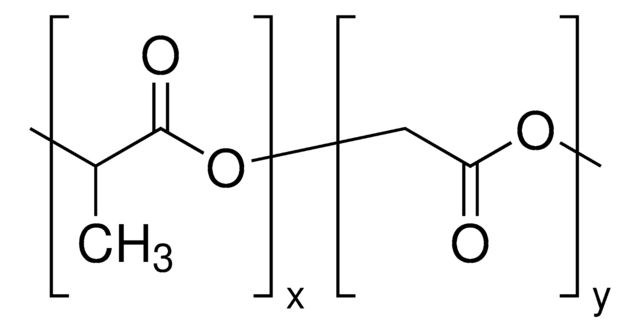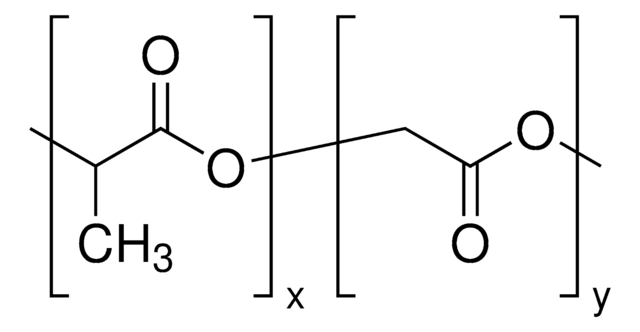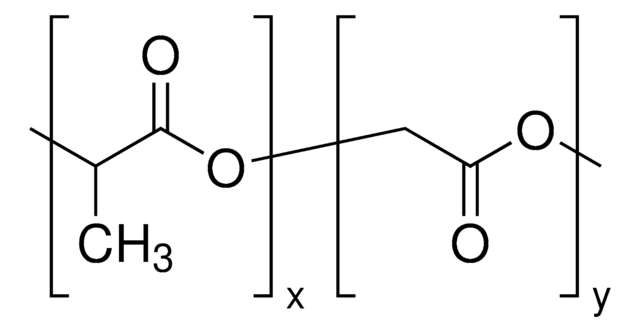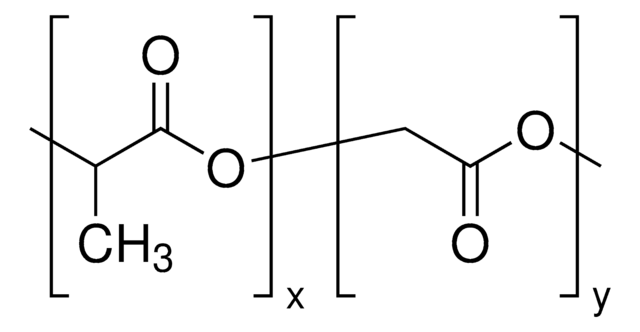Kluczowe dokumenty
430471
Poly(D,L-lactide-co-glycolide)
ester terminated, Mw 50,000-75,000
Synonim(y):
Lactel® B6006-1, PLGA
About This Item
Polecane produkty
Poziom jakości
Formularz
amorphous
proporcje
lactide:glycolide 85:15
masa cząsteczkowa
Mw 50,000-75,000
ramy czasowe degradacji
<6 months
lepkość
0.55-0.75 dL/g, 0.1 % (w/v) in chloroform(25 °C)
temp. przejścia
Tg 45-50 °C
rozpuszczalność
ethyl acetate, chloroform, acetone and THF: soluble
temp. przechowywania
2-8°C
ciąg SMILES
OCC(O)=O.CC(O)C(O)=O
InChI
1S/C3H6O3.C2H4O3/c1-2(4)3(5)6;3-1-2(4)5/h2,4H,1H3,(H,5,6);3H,1H2,(H,4,5)
Klucz InChI
XBBVURRQGJPTHH-UHFFFAOYSA-N
Szukasz podobnych produktów? Odwiedź Przewodnik dotyczący porównywania produktów
Powiązane kategorie
Opis ogólny
Zastosowanie
Cechy i korzyści
Postać fizyczna
Informacje prawne
Kod klasy składowania
11 - Combustible Solids
Klasa zagrożenia wodnego (WGK)
WGK 3
Temperatura zapłonu (°F)
Not applicable
Temperatura zapłonu (°C)
Not applicable
Środki ochrony indywidualnej
Eyeshields, Gloves, type N95 (US)
Wybierz jedną z najnowszych wersji:
Masz już ten produkt?
Dokumenty związane z niedawno zakupionymi produktami zostały zamieszczone w Bibliotece dokumentów.
Klienci oglądali również te produkty
Produkty
Interest in utilizing biodegradable polymers for biomedical applications has grown since the 1960s.
Syntetyczne poliestry alifatyczne dominują wśród biomateriałów resorbowalnych w zastosowaniach klinicznych.
The world of commercial biomaterials has stagnated over the past 30 years as few materials have successfully transitioned from the bench to clinical use. Synthetic aliphatic polyesters have continued to dominate the field of resorbable biomaterials due to their long history and track record of approval with the U.S. Food and Drug Administration (FDA).
Aliphatic polyesters such as polylactide, poly(lactide-co-glycolide) and polycaprolactone, as well as their copolymers, represent a diverse family of synthetic biodegradable polymers that have been widely explored for medical uses and are commercially available.
Global Trade Item Number
| SKU | GTIN |
|---|---|
| 430471-1G | 4061835563029 |
| 430471-5G | 4061835563036 |
Nasz zespół naukowców ma doświadczenie we wszystkich obszarach badań, w tym w naukach przyrodniczych, materiałoznawstwie, syntezie chemicznej, chromatografii, analityce i wielu innych dziedzinach.
Skontaktuj się z zespołem ds. pomocy technicznej




